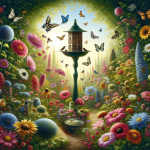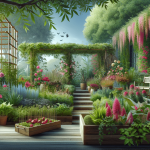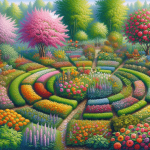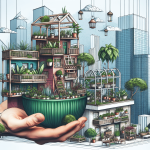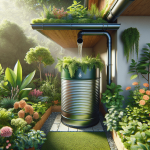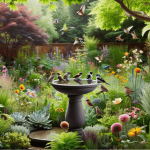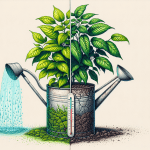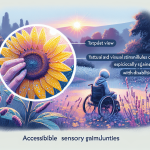This post may contain affiliate links. As an Amazon Associate, we may earn commissions from qualifying purchases.
Are you ready to create a stunning garden that will be the envy of your neighbors? Planning and designing a garden layout may seem like a daunting task, but fear not! With a little bit of knowledge and some creativity, you can transform your outdoor space into a beautiful oasis. Whether you’re an experienced gardener or a complete novice, this article will guide you through the process, providing tips and ideas for how to plan and design your dream garden. So grab your gardening gloves and get ready to dig in!
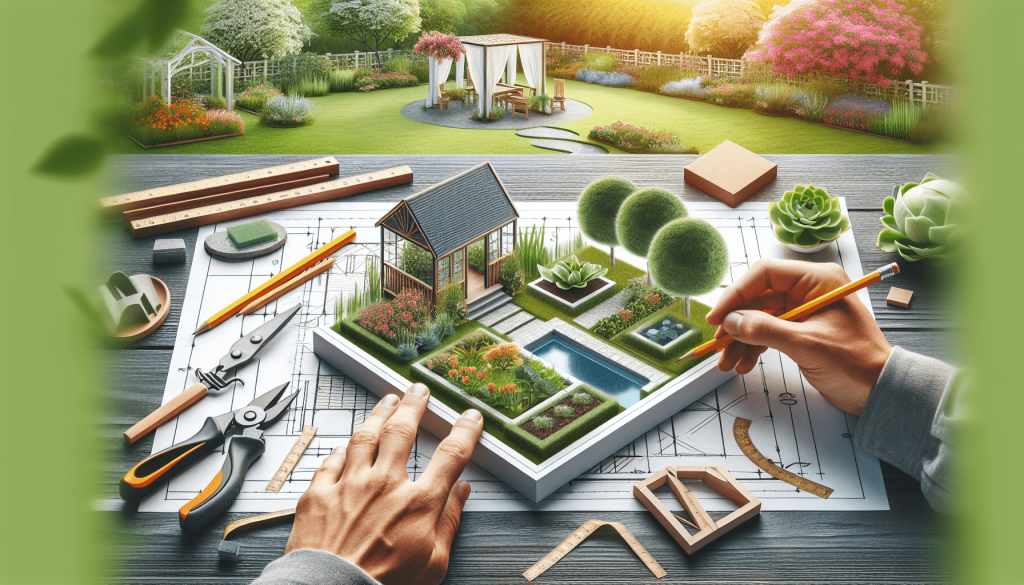
Assess Your Space
When it comes to planning and designing your garden, the first step is to assess your space. Determine the size and shape of your garden. Is it rectangular, square, or maybe irregular? This will help you visualize how much space you have to work with and what kind of layout might be most suitable.
Next, consider the existing features of your space. Do you have any trees, shrubs, or structures already in place? Take note of these elements and think about how they can be incorporated into your garden design. It’s always a good idea to work with what you have and build upon it.
In addition, pay attention to the sun exposure and drainage in your garden. Observe how the sun moves throughout the day and identify areas that receive more or less sunlight. This will help you determine what types of plants will thrive in each area. Similarly, consider the drainage in your garden. Are there areas that tend to be soggy or prone to flooding? This will inform your plant choices, as some plants prefer well-drained soil while others tolerate more moisture.
Set Your Goals
After assessing your space, it’s time to set your goals for the garden. Start by deciding on the purpose of your garden. Are you looking to create a peaceful oasis for relaxation, or do you want a vibrant space filled with flowers and colors? Identifying the purpose will guide your design choices and help create a cohesive overall look.
Next, consider your needs and preferences. Do you have children or pets that will be using the garden? Do you enjoy gardening and want to incorporate a vegetable patch or herb garden? Take into account these factors and any specific requirements you may have.
Finally, establish a budget for your project. This will help you prioritize your expenses and make smart decisions when it comes to purchasing plants, materials, and other elements for your garden. It’s always a good idea to have a clear budget in mind to avoid overspending.
Research and Gather Inspiration
Before diving into the actual design process, take some time to research and gather inspiration. Look for garden design ideas and styles that resonate with you. Browse through gardening books, magazines, and websites to get a sense of different aesthetics and possibilities.
In addition, explore different plant options. Take note of plants that catch your eye and would thrive in your climate and soil conditions. Consider factors such as color, texture, height, and bloom time. There are countless plants to choose from, so this research will help narrow down your options and create a more cohesive and visually appealing garden.
To further fuel your creativity, visit botanical gardens or public gardens in your area. These spaces are often beautifully designed and can provide inspiration for your own garden. Take note of the layouts, plant combinations, and overall ambiance. Allow yourself to be inspired by the creativity and expertise of others.
Layout and Design
Now that you have gathered inspiration, it’s time to begin the layout and design process. Start by developing a rough sketch or plan of your garden. You don’t need to be an artist for this step – a simple hand-drawn sketch will do. This will help you visualize how different elements will fit together and allow you to make adjustments before committing to the final design.
Consider the focal points and focal areas of your garden. These are the areas that will draw the most attention and should be highlighted. Think about incorporating eye-catching features such as a sculpture, a colorful flower bed, or a beautifully arranged seating area.
Divide your garden into functional zones based on your goals and needs. This could include areas for dining and entertaining, a play zone for children, a quiet reading nook, or a vegetable garden. Each zone should serve a specific purpose and be designed accordingly.
Plan for pathways and access points to ensure easy movement throughout the garden. Pathways can be made with various materials such as gravel, stone, or bricks. Think about how people will navigate through your garden and create logical pathways that follow the natural flow of the space.
Don’t forget to include seating and entertaining areas in your design. Whether it’s a cozy bench, a dining table with chairs, or a hammock, make sure to incorporate spaces where you can relax, socialize, and enjoy your garden.
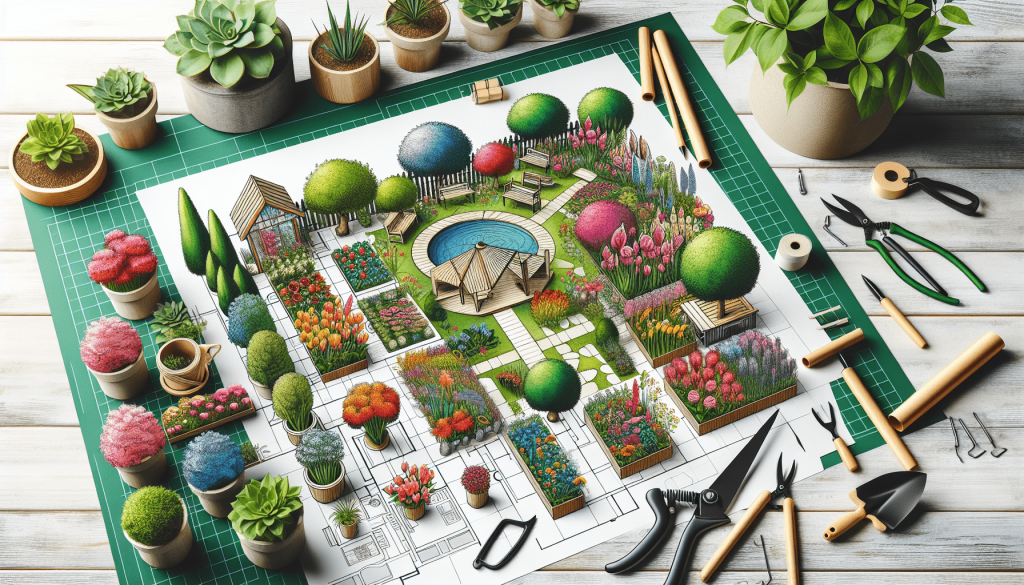
Choosing Plants
Choosing the right plants is crucial for a successful garden. Start by researching plants that are suitable for your climate and soil conditions. Consider factors such as temperature, humidity, and average rainfall. Local gardening centers and nurseries can provide valuable information and guidance in selecting the appropriate plants for your area.
When selecting plants, aim for a variety that will provide interest and beauty throughout the year. Consider plants with different bloom times, foliage colors, and textures. This will ensure that your garden looks vibrant and dynamic throughout the seasons.
Take into account the maintenance requirements of your chosen plants. Some plants require more care and attention than others. If you’re new to gardening or have limited time for maintenance, opt for low-maintenance plants that are easy to care for.
Group plants with similar water and sunlight needs together. This will make it easier to provide the appropriate care and create a more efficient watering schedule. Additionally, grouping plants with similar needs creates a harmonious look and ensures optimal growth.
Structures and Features
Structures and features can add depth and interest to your garden design. Consider the need for structures like pergolas, trellises, or arbors. These elements can provide height and vertical interest, while also serving as support for climbing plants or providing shade.
Another option to enhance the design of your garden is by incorporating water features or sculptures. The sound of running water or the visual appeal of a well-placed sculpture can create a sense of tranquility and elegance.
Additionally, think about including functional features like raised beds or compost bins. Raised beds not only add visual interest but also provide better drainage and easier access for planting and maintenance. Compost bins are a great way to recycle organic waste and create nutrient-rich soil for your plants.
Color and Texture
Color and texture play a significant role in garden design. Choose a color scheme that matches your preferences and complements the overall aesthetic you’re going for. You can opt for a harmonious color palette where similar shades are used, or create contrast by combining complementary colors.
Consider the textures and shapes of leaves and flowers when selecting plants. Some plants have large, bold leaves, while others have delicate and fine foliage. Similarly, flowers come in various shapes, sizes, and textures. Combining different textures adds visual interest and creates a more dynamic and visually appealing garden.
To create contrast and focal points, strategically place plants with different colors and textures. This will draw attention to specific areas and add depth to your garden. Experiment with different combinations and arrangements to find the perfect balance for your space.
Add Hardscape Elements
Hardscape elements such as pathways, patios, or decks can greatly enhance your garden design. Incorporate these elements into your layout to provide structure and functionality to your outdoor space.
When choosing materials for your hardscape, consider your garden style and personal preferences. Natural materials like gravel, stone, or wood can create a more rustic and organic look, while concrete or tiles offer a modern and sleek aesthetic. Make sure to choose materials that complement the overall design of your garden.
In addition to aesthetics, consider the practicality and functionality of the hardscape elements. Ensure that pathways are wide enough for comfortable passage, and that patios or decks provide ample space for seating or outdoor activities. It’s important to strike a balance between beauty and practicality in your garden design.
Implement Your Design
Once you have completed the planning and design phase, it’s time to implement your vision and bring your garden to life. Start by preparing the soil and ensuring proper drainage. Remove any weeds or unwanted plants, loosen the soil, and amend it with compost or other organic matter if necessary.
Next, start planting based on your plan and plant choices. Follow the recommended planting depths and spacing for each plant, and make sure to water them thoroughly after planting. Take your time and enjoy the process of watching your garden come together.
Regularly maintain and care for your garden as it grows and develops. This includes regular watering, pruning, and fertilizing. Stay vigilant for signs of pests or diseases and address them promptly to prevent any damage to your plants. Enjoy the process and take pride in the growth and beauty of your garden.
Evaluate and Adjust
After some time, step back and assess the success and functionality of your garden layout. Take note of what works well and what could be improved. Consider how the garden aligns with your goals and needs, and whether any adjustments are necessary.
Monitor the growth and health of your plants. Observe how they are adapting to their environment and make notes of any issues or areas for improvement. This will help you make informed decisions for future planting choices and adjustments to the design.
Don’t be afraid to make changes and adjustments to your garden design if needed. Gardening is a continuous learning process, and it’s natural to refine and adapt your design as you gain experience and knowledge. Embrace the opportunity to experiment and create a garden that brings you joy and satisfaction.

